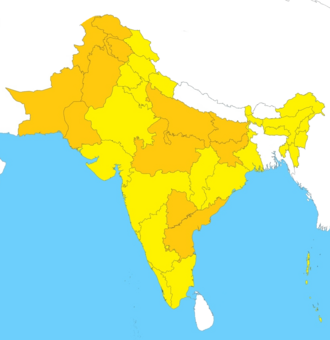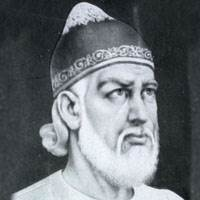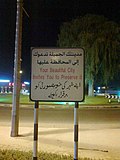Urdu
Urdu, also known as Lashkari,[6] or the Lashkari language (لِشْکری زَبَانِ)[7] is the national language of Pakistan and a recognized regional dialect in India. Urdu is an Indo-Aryan language, which means that it came from Proto-Indo-Aryan, a language that was spoken northeast of the Caspian Sea in the second millennium BCE.[8]
| Urdu | ||||
|---|---|---|---|---|
| Lashkari (لِشٍّکری) اُرْدُو | ||||
 Urdu in Nastaliq script | ||||
| Pronunciation | [ˈʊrduː] ( | |||
| Native to | India and Pakistan | |||
| Region | South Asia | |||
| Native speakers | 68.62 million (2021) Total: 230 million (2021)[1] | |||
| Language family | ||||
| Early forms: | Hindustani
| |||
| Dialects | ||||
| Writing system |
| |||
| Official status | ||||
| Official language in | (national)
| |||
| Recognised minority language in | ||||
| Regulated by | National Language Promotion Department (Pakistan) National Council for Promotion of Urdu Language (India) | |||
| Language codes | ||||
| ISO 639-1 | ur | |||
| ISO 639-2 | urd | |||
| ISO 639-3 | urd | |||
| Linguasphere | 59-AAF-q | |||
 Areas in India and Pakistan where Urdu is either official or co-official
Areas where Urdu is neither official nor co-official | ||||
| ||||
Most people in Pakistan speak it as a lingua franca. There are parts of India that speak it, such as Delhi, Bihar, and Uttar Pradesh, for example. Despite a few differences, the words in Hindi are very similar to Urdu. The way it is written, is different from how Hindi is written. People who speak Hindi and Urdu may be able to able to understand or express the meaning of one of these two scripts in any order.
History
In the 11th century AD, the Ghaznavid Empire ruled over Punjab, the region characterized by five rivers.[9]
Also known as Hind, the Punjab was a land east on the Indus River.[10]
The primary language spoken by Ghaznavids, who were of Turkic ethnicity, was Persian. The Ghaznavids met the people who spoke an Indo-Aryan dialect after acquiring Punjab or Hind, which had Lahore as its capital. The contemporary Punjabi language also derives from this language indigenous to the region.[11]
A distinctive dialect, dubbed 'Lashkari Zaban,' was created when Persian began to influence the language of the natives of the region.[9][12]
The Ghaznavids and inhabitants of the area adopted this new language. In the 12th century AD, the Ghaznavids moved to the west of present-day India and brought this language to Delhi. The language was influenced by the Khariboli dialect that was spoken in the area.[13]
From Delhi it spread to the northern regions, where it became a standard way of interacting. Khariboli's influence on the language spread to cities like Lucknow and Hyderabad. Over the course of time, the language has been referred to in numerous ways.[14]
Native poets from these cities and the surrounding areas helped improve it by adding many Persian and Chagatai words to it. They added Arabic words in the language that already existed from Persian.
During the Delhi Sultanate, the language continued to change.
The 'Mughal Empire' was a distinct Muslim empire of Turkic origin, with primary language Chagatai and secondary language Persian. But they did not have any signs that they were from Iran or the Persian region.
At that time, the royal camps' dialect was known as Zaban-i-Ordu.
It is said that the late eighteenth-century AD poet Ghulam Mashafi bestowed upon it the designation “Urdu”, which was shortened from “Zaban-i-Urdu.”[15]
The name "urdu" originated from Chagatai. Chagatai was part of the same Turkic family, like Uzbek and Uyghur languages.
In its own indigenous translation, it was a Lashkari Zaban and Lashkari for short.
The language commonly referred to as Urdu was used as a court language in numerous South Asian cities, including Delhi and Amritsar.[9]
During the time of the British Empire, it gained the designation of "Hindustani." Hindustan, a name associated with the Indus River. The court proceedings were continuing in the language.
It eventually became the first language of many people in North India.
By the end of British rule and the independence of Pakistan, it was selected as the national language for the people of the country because they spoke different languages and dialects.
In India, it became the national language but went by the name Hindi and was written in the Devanagari script. It also used a lesser amount of Arabic, Persian, and Chagatai words and instead, Sanskrit words were adopted in their place.
Today, it is the most widely spoken language in Pakistan in terms of total speakers and a registered language in 22 Indian states.
Relations to Persian
Differences
The letters in Urdu are derived from the Persian/Farsi alphabet, which is derived from the Arabic alphabet. The additional letters that are found in Urdu include ٹ ,ڈ ,ڑ (ṫ, ḋ, ṙ). To make the alphabet more enriched, two letters were created for the sounds ه (h) and ی (y). By adding these letters to the existing Persian letters, the Urdu alphabet became more suitable for the people of Pakistan and for some people of North India, who primarily use nastaliq script. Both are also Indo-Iranic languages descending from Proto-Indo-Iranic, but deriving from separate subbranches, Iranic and Indo-Aryan respectively.
Similarities
Urdu is written right to left like Farsi (Persian) script. Urdu is also written in the Nasta’ liq style of Persian Calligraphy. Nastaliq style is a cursive script invented by Mīr ʿAlī of Tabrīz, a very famous calligrapher during the Timurid period (1402–1502). Both belong to the Indo-Iranic language subfamily.
Levels of formality
Informal
Urdu in its less formalized register has been called a rekhta (ریخِتْہ,), meaning "rough mixture". The more formal register of Urdu is sometimes called zabān-e-Urdu-e-mo'alla (زَبَّانُ ارْدُو مُعْلٍہ [zəbaːn eː ʊrd̪uː eː moəllaː]), the "Language of Camp."
In local translation, it is called Lashkari Zabān (لِشْکری زَبَانِ [lʌʃkɜ:i: zɑ:bɑ:n])[16] meaning "language of battalions" or "battalion language." This can be shortened to Lashkari.
The etymology of the word used in the Urdu language, for the most part, decides how nice or well done your speech is. For example, Urdu speakers would distinguish between پانی pānī and آب āb, both meaning "water" for example, or between آدمی ādmi and مرد mard, meaning "man." The first word is ad derivative from Adam (آدم) Arabic means from Adam, and it can be used for both man and woman in place of human being. The second word مرد mard refers to a gender or can be used for manly hood as well.
If a word is of Persian or Arabic origin, the level of speech is thought to be more formal. If Persian or Arabic grammar constructs, such as the izafat, are used in Urdu, the level of speech is also thought more formal and correct. If a word is inherited from Chagatai, the level of speech is thought more colloquial and personal.[17]
Formal
Urdu is supposed to be a well-formed language; many of words are used in it to show respect and politeness. This emphasis on politeness, which comes from the vocabulary, is known as Aadab (Courteous) and to sometimes as takalluf (Formal) in Urdu. These words are mostly used when addressing elders, or people with whom one is not met yet. Just like French Vous and Tu. Upon studying French and other forms of Language, similar formal language constructs are present. The whole grammatical layout appears to be almost identical to French language structure. The rules for forming sentences and structuring them are identical
Poetics

Two well-respected poets who are not only celebrated in the South Asian subcontinent, but are famous in many other communities worldwide are Mirza Ghalib and Sir Dr. Muhammed Iqbal.
Mirza Ghalib
Ghalib (1797-1869) is well-known for his classic satire and sarcasm, as seen in the following verse;
(Latin/Roma alphabet):
Umer bhar hum yun hee ghalati kartey rahen Ghalib
Dhool ch-herey pei thee aur hum aaina saaf karte rahe
(translation):
O Ghalib (himself) all my life I kept making the same mistakes over and over,
I was busy cleaning the mirror while the dirt was on my face.
Sir Dr Muhammed Iqbal
Iqbal (1877-1938) was a poet, and an active politician. He focused his poetry on bringing out the plight of the suffering Muslim community of British India. In his poetry, he very boldly highlighted the missing virtues and values in the morally corrupt Indian society. Despite much opposition in the beginning, he ended up leaving a considerable impact. He is also called the “Poet of the East” and the “Poet of Islam”. His work is displayed in the following verse;
(Latin/Roma Alphabet):
Aapne bhe khafa mujh sei beganey bhe na khush
Mein zeher-e-halahal ku kabhi keh na saka qand
(translation):
I could not keep happy either my loved ones or the strangers,
as I could never call a piece of poison a piece of candy.
Iqbal is considered by many an inspirational poet. He played a large role in the Pakistan Movement, with many claiming that he was the one to imagine and initiate it.
Common Words/Phrases in Urdu
Formal Urdu:
Aap tashreef rakhein = Please have a seat
Main mu'azzarat chahta/chahti hun = Please excuse me/I apologize
Informal Urdu: Aap bethein (You sit) or Tum betho (Sit, more informal)
Main maafi chahta/chahti hun= I ask for forgiveness
*************
Aap kaisay hein? = How are you?
Main sahein hun = I am fine
Assalam O Alaikum = Peace be upon you (It basically means hello, and it is a common greeting used in Islamic countries or among Muslims in general)
Urdu vs. Hindi--What's the difference?
Although often misunderstood as two separate languages, Urdu and Hindi are two registers of the same Hindustani language, often called Hindi-Urdu.[18] Urdu is the official language of Pakistan and spoken by 71 million people in India.[19] Urdu's vocabulary borrows primarily from Chagatai, Sanskrit, Persian and Arabic. Hindi, also historically known as Hindui (हिंदुई),[20] is the most spoken language of India, which replaces much of Urdu's Farsi, Chagatai and Arabic terminology with Sanskrit derived vocabulary. They are grammatically the same. Everyday words are often shared between the two registers, while formal vocabulary can differ significantly. Urdu and Hindi speakers can understand each other with little to no difficulty, largely from using shared, or English vocabulary, rather than using highly Arabized or Sanskritized vocabulary. Hindi speakers are more likely to use words of Arabic/Persian origin (Kitaab, Dil, Mahobbat), than Urdu speakers are to use words of Sanskrit origin (Pustak, Man, Prem), as Urdu-speaking Pakistani's have less exposure to Hindi, than Hindi-speaking Indians do to Urdu. This can be seen in Bollywoods extensive use of the Urdu register,[21] and India being a nation where both registers are natively spoken.[22]
Example
English: I want to know how your mind is feeling.
Literary Urdu: Mujhe aap ke dimaagh ki jazbaat maatloob hai.
Literary Hindi: Mujhe aap ke mastishk ka bhaav vaanchit hai.
Casual Hindustani: Main tere man* ka haal* jaanna chaata hun.
*man is of Sanskrit origin, while haal is of Arabic origin[23][24]
Urdu Media
Opening pages of the Urdu divan of Ghalib, 1821
The proportion of people with Urdu as their mother tongue in each Pakistani district as of the 2017 Pakistan census.
The phrase Zubān-e-Urdū-e-Muʿallā ("the language of the exalted camp") written in the Perso-Arabic script
The Urdu alphabet, with transliterations in the Roman and Devanagari scripts
References
- ↑ "What are the top 200 most spoken languages?". Ethnologue. 3 October 2018. Retrieved 2021-02-26.
- ↑ Hindustani (2005). Keith Brown (ed.). Encyclopedia of Language and Linguistics (2 ed.). Elsevier. ISBN 0-08-044299-4.
- ↑ "Urdu is Telangana's second official language" (in en-US). The Indian Express. 16 November 2017. http://indianexpress.com/article/india/urdu-is-telanganas-second-official-language-4940595/. Retrieved 27 February 2018.
- ↑ "Urdu is second official language in Telangana as state passes Bill". The News Minute. 17 November 2017. https://www.thenewsminute.com/article/urdu-second-official-language-telangana-state-passes-bill-71742. Retrieved 27 February 2018.
- ↑ "Constitution of the Republic of South Africa, 1996 - Chapter 1: Founding Provisions". www.gov.za. Retrieved 6 December 2014.
- ↑ Aijazuddin Ahmad (2009). Geography of the South Asian Subcontinent: a critical approach. Concept Publishing Company. pp. 120–. ISBN 978-81-8069-568-1.
The very word Urdu came into being as the original Lashkari dialect, in other words, the language of the army.
- ↑ *Khalid, Kanwal. "Lahore During The Ghaznavid Period: A Socio- Political and Cultural Study."
- ↑ Trautmann, Thomas, and Yoda Press. "Indo-European topics."
- ↑ 9.0 9.1 9.2 Dogra, Ramesh Chander. "Cataloguing Urdu Names." International Library Review 5.3 (1973): 351-377.
- ↑ Brard, Gurnam Singh Sidhu. "East of Indus: My memories of old Punjab." (2007).
- ↑ Nazir Ahmed Chaudhry (1998). Lahore: Glimpses of a Glorious Heritage. Sang-e-Meel Publications, 1998, University of Michigan (origin). p. 18. ISBN 9693509447.
- ↑ *Khalid, Kanwal. "Lahore During The Ghaznavid Period: A Socio- Political and Cultural Study."
- ↑ Bailey, T. Grahame. "Urdu: the Name and the Language." Journal of the Royal Asiatic Society 62.2 (1930): 391-400.
- ↑ Shaheen, Shagufta, and Sajjad Shahid. "The Unique Literary Traditions of Dakhnī." Languages and Literary Cultures in Hyderabad (2017): 7.
- ↑ 15.0 15.1 Garcia, Maria Isabel Maldonado. "The Urdu language reforms." Studies 26 (2011): 97.
- ↑ Khan, Sajjad, Waqas Anwar, Usama Bajwa, and Xuan Wang. "Template Based Affix Stemmer for a Morphologically Rich Language." International Arab Journal of Information Technology (IAJIT) 12, no. 2 (2015).
- ↑ "About Urdu". Afroz Taj (University of North Carolina at Chapel Hill). Retrieved 2008-02-26.
- ↑ "Yes, Hindi and Urdu are the same language". Oxford IRSoc. 2017-02-22. Retrieved 2023-06-30.
- ↑ "Urdu - Worldwide distribution". Worlddata.info. Retrieved 2023-06-30.
- ↑ Dwyer, Rachel. "Hindi/Hindustani". Key Concepts in Modern Indian Studies, edited by Gita Dharampal-Frick, Monika Kirloskar-Steinbach and Jahnavi Phalkey, New York, USA: New York University Press, 2016, pp. 102-103. https://doi.org/10.18574/9781479826834-041
- ↑ "Is Urdu losing its charm in Bollywood films?". Deccan Herald. 2021-02-27. Retrieved 2023-06-30.
- ↑ Hashmi, Rasia (2019-09-02). "Urdu is the 2nd most spoken language in 5 states". The Siasat Daily. Retrieved 2023-06-30.
- ↑ "Meaning of man in English". Rekhta Dictionary. Retrieved 2023-06-30.
- ↑ "Meaning of haal in English". Rekhta Dictionary. Retrieved 2023-06-30.
Further reading
- ترتیب وڈیزائننگ ایم پی خاؿ اردولشکری زبان (sample texts)
Other websites
- Omniglot page the online encyclopedia of languages and writing systems
| This language has its own Wikipedia project. See the Urdu edition. |









